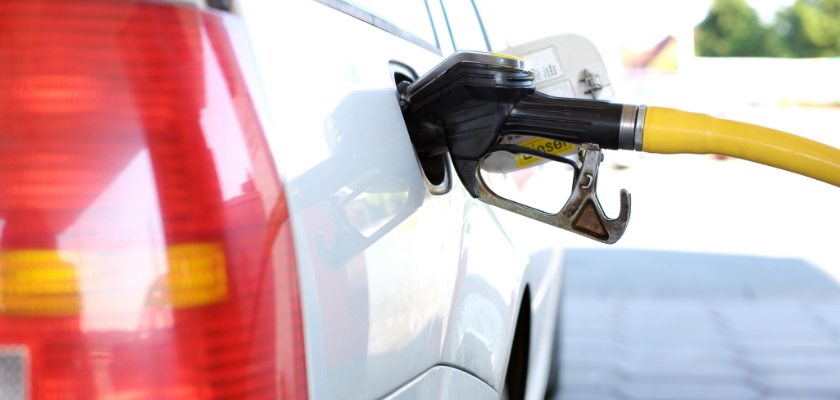Fuel costs can make up 30 to 40 percent of a fleet’s cost per mile, according to the American Transportation Research Institute — often the single largest expense in a company’s budget.
Even when diesel fuel prices are not at record highs, businesses that take steps to reduce their gas consumption can see a significant boost to their bottom line.
These four behavior changes can help reduce fuel costs while also improving safety — a win-win for any fleet.
1. Reduce fuel costs by cutting down idle time
Cutting idle time is one of the easiest ways to trim a fleet’s total fuel costs.
After all, idling vehicles get zero mpg, and an idling truck wastes one full gallon of diesel gas per hour. The US Department of Energy estimates that idling vehicles waste six billion gallons of fuel each and every year.
While some believe that idling takes less fuel than restarting the engine, the reality is quite different: just ten seconds of idling uses more fuel than starting the engine.
Plus, states and some municipalities have their own idling limits, ranging from three to fifteen minutes. The American Trucking Research Institute has compiled the regulations into a single reference document that can help drivers avoid citations and fines.
Technology can identify idling habits and offer opportunities for behavior changes. Fleet management solutions can be programmed to report instances when idling goes beyond a set duration to account for unavoidable idling in traffic or construction.
2. Lower fuel costs by breaking the cycle of aggressive driving
Some drivers get trapped in a vicious cycle of aggressive behavior that involves following too closely and braking or accelerating hard. These aggressive driving habits force the engine to switch gears inefficiently, increasing RPMs with a surge of fuel. This can cut gas mileage by 15 to 30 percent at highway speeds and up to 40 percent in stop-and-go traffic.
Aggressive driving causes more wear and tear on brakes and engines — not to mention a greater risk of collisions. And after all that, drivers usually don’t even reach their destination any quicker.
Many drivers don’t realize that they have developed aggressive driving habits. According to Rob Abbott, commercial leader, enterprise trucking, at Lytx, “It’s just how that person has driven.”
Abbott recommends using fleet management systems with video telematics to identify drivers who habitually accelerate hard. Then, ride along with them to reinforce defensive driving habits, such as anticipating road conditions and watching upcoming traffic signals.
Sometimes hard braking is essential to avoid a collision, but reducing its frequency can pay off by reducing the average fuel cost per trip. If you have video on board, you can use it to tell if someone is braking hard to avoid a collision, or for another reason.
Remind drivers that the pressing of the gas pedal directly impacts fuel consumption — and the fleet’s overall fuel costs.
3. Reduce fuel costs by providing feedback to employees about the most problematic behaviors
Fleets that openly communicate with drivers to address specific behaviors tend to see the best results.
For example, speeding may be rampant among a group of drivers. If their manager asks those drivers to work on driving closer to the speed limit, they can change their behaviors. And since every 5 miles traveled above 35 mph reduces fuel efficiency by 5 to 10 percent, these efforts can translate to lower fuel costs.
One 62-vehicle public transit fleet, West Texas’ Concho Valley Transit District, was surprised when DriveCam data revealed that speeding was often correlated with distracted driving. By starting a focused coaching program that showed drivers where their hands and eyes were during speeding incidents, Concho Valley dramatically reduced violations. 95 percent of drivers eliminated the behavior after a single speeding-focused coaching session.
4. Use technology to calculate how habits drive costs
Advanced fuel cost estimators and calculators can paint a clearer picture of a fleet’s fuel consumption. The Lytx Fleet Tracking Service includes a Fleet Data Report that processes ECM or GPS data to calculate:
- Average speed
- Total engine hours (divided into driving hours vs idle time)
- Total fuel consumption (including both driving and idling time)
- Idling fuel consumption (divided into greater and less than 800 rpm)
- Fuel economy (distance traveled divided by total fuel consumed)
- Driving fuel economy (distance traveled divided by driving fuel)
These indicators can show exactly where idling is causing major dips in average fuel economy.
But that’s only part of the solution. GPS fleet tracking can pinpoint other opportunities to reduce fuel costs, such as offering insights that may help fleets choose more efficient routes that avoid road construction and traffic congestion.
Going even farther, video telematics can reveal risky driving behaviors and offer opportunities for targeted feedback.
Then add it all up. Look at your average fuel prices and use the Lytx savings calculator to see how much you can save in fuel, maintenance, and safety-related costs. Share these numbers with your team to drive home how fuel costs relate to their behavior.
Together, these four strategies can provide you with the ultimate defense against fuel costs. See how the Lytx Fleet Tracking Service can help you proactively manage your fuel and other related costs. Schedule a free demo.
